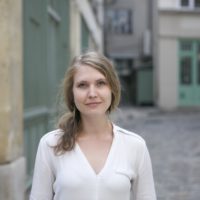It’s a simple class photo, in black and white. Twenty little girls, aged around 8 to 10, stare unsmiling at the lens, intimidated under their embroidered bonnets. “These are my two aunts and my mother,” says Rose-Marie Huuva[1], her finger sliding across the picture. In the café in Kiruna, in the far north of Sweden, where she has arranged to meet us, the Sámi poet, from the last indigenous people of Europe, has her archives, notes, poetry collections, fragments of family history, and her people’s history, next to her steaming cup. Rose-Marie has always known this photo. Her mother had a small reproduction of it at home, a souvenir of her years at the nomadic school where the children of Sámi herders were sent[2]. “But she didn’t talk about it,” says the poet. “It was only much later that I learned the context in which the photo was taken. And what probably happened afterwards.”
This picture is not in fact an ordinary school photo. It was taken by the Rasbiologiska Institutet – the Institute of Racial Biology – founded in Uppsala, north of Stockholm, in 1922. At the time, racial theory and its counterpart, eugenics[3], were particularly popular in Europe and across the Atlantic, and Sweden was a pioneer in this field. The Uppsala Institute was the first of its kind to be directly funded by a state, and its founder, Herman Lundborg, was a leading figure. Foreign researchers passed through its corridors to be inspired by Swedish methods, including Hans F. K. Günther, the future Third Reich eugenicist. They talked about cranial characteristics, the dangers of race mixing and sterilisation.
Throughout the 1920s and 1930s, the Institute sent its researchers to conduct field studies, particularly in the North, to classify the different populations of Sweden. There, they set about documenting their characteristics and way of life. All across Sápmi[4], men and women were gathered to have their skulls measured and photos taken, dressed and naked, front and profile, all with this cold scientific detachment. And since it was thought necessary to be exhaustive, the research was not limited to adults.
“My mother’s class photo was taken in 1931,” says Rose-Marie Huuva. “On that day, the children from the nomadic school were taken to the village. It must have been uncommon and exciting for them. But this picture was not the only one the scientists wanted. Afterwards, the children were taken individually to a room,” continues the poet, her voice vibrating with anger. “They were stripped naked and photographed. And nobody was there to protect them! No one!”
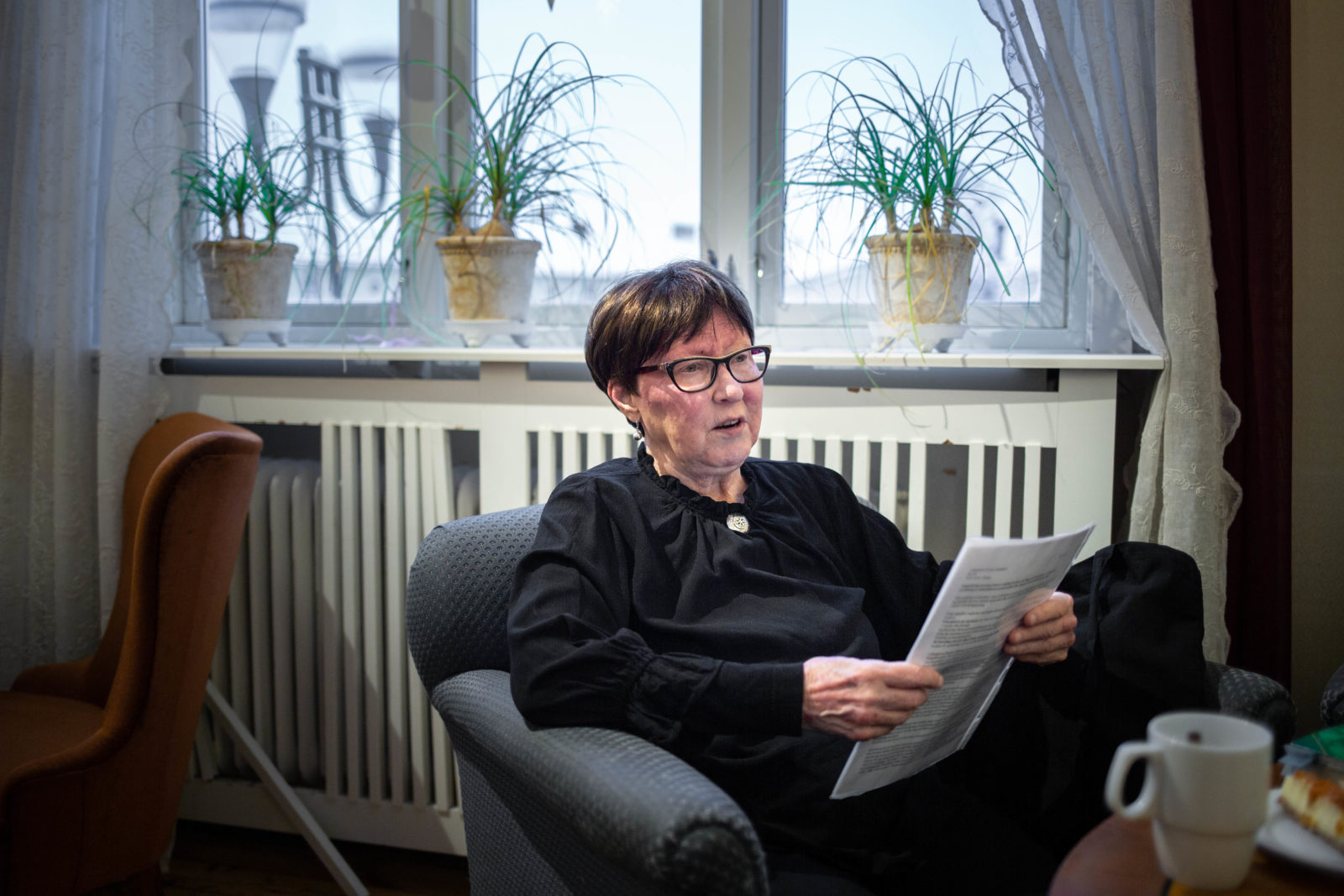
The poet Rose-Marie Huuva in Kiruna on December 7, 2021 – Photos Thomas Dévényi/Hans Lucas for Les Jours.
A few years later, echoes of the terrible German racial politics would somehow dampen the Swedish state’s enthusiasm for eugenic theories. The Institute was eventually reoriented towards genetic and medical research, and the sordid studies of the past were consigned to the archives – where they still reside. A thousand kilometres south of Kiruna, in the warehouses of the august Carolina-Rediviva Library, the 12,000 or so images collected a century ago by the Institute’s researchers lie in large brown leather albums. Anyone who makes a request is free to consult these documents – subject to a confidentiality agreement, due to the sensitivity of such archives.
This is where Rose-Marie Huuva went, 85 years after this particular class photo was taken. “When I discovered all the pictures, it was a real shock,” she says. “I walked out of the library and wanted to scream”. What upsets her so much is that these images “stolen” from the Sámi[5] people do not belong to them. “I don’t think they should be destroyed, it’s dangerous to want to erase the past. But we should be able to decide who has access to them and for what purpose,” she says, clasping her hands over her coffee cup, “because looking at such intimate images is like raping our loved ones a second time.”
A few blocks away, in downtown Kiruna, Rose-Marie’s friend Carina Sarri[6] has hung portraits of her great-grandparents, taken by the Institute a century ago, in her living room alongside her family photos. “What the Institute did was wrong, it’s painful to think that these images belong to that heritage. But on the other hand, these are the only photographs ever taken of my great-grandparents,” she explains. “Without them, I wouldn’t have any images to remember them by.”
“This is the ambiguity of research in the North in the 19th and 20th centuries,” says an employee of the Saami Parliament[7] a few days later. “While the practices and objectives of the Rasbiologiska Institutet are unjustifiable, many other researchers were studying our people at the time. There was this idea that the Sámi were a ‘first nation’ whose way of life had to be documented before it disappeared”. This anthropological approach was certainly imbued with a fascination for “savages” and a strong belief in the superiority of “civilisation”. “But today, this same research, however questionable, is one of the rare sources of documentation on our ancestors,” says the Saami Parliament worker.
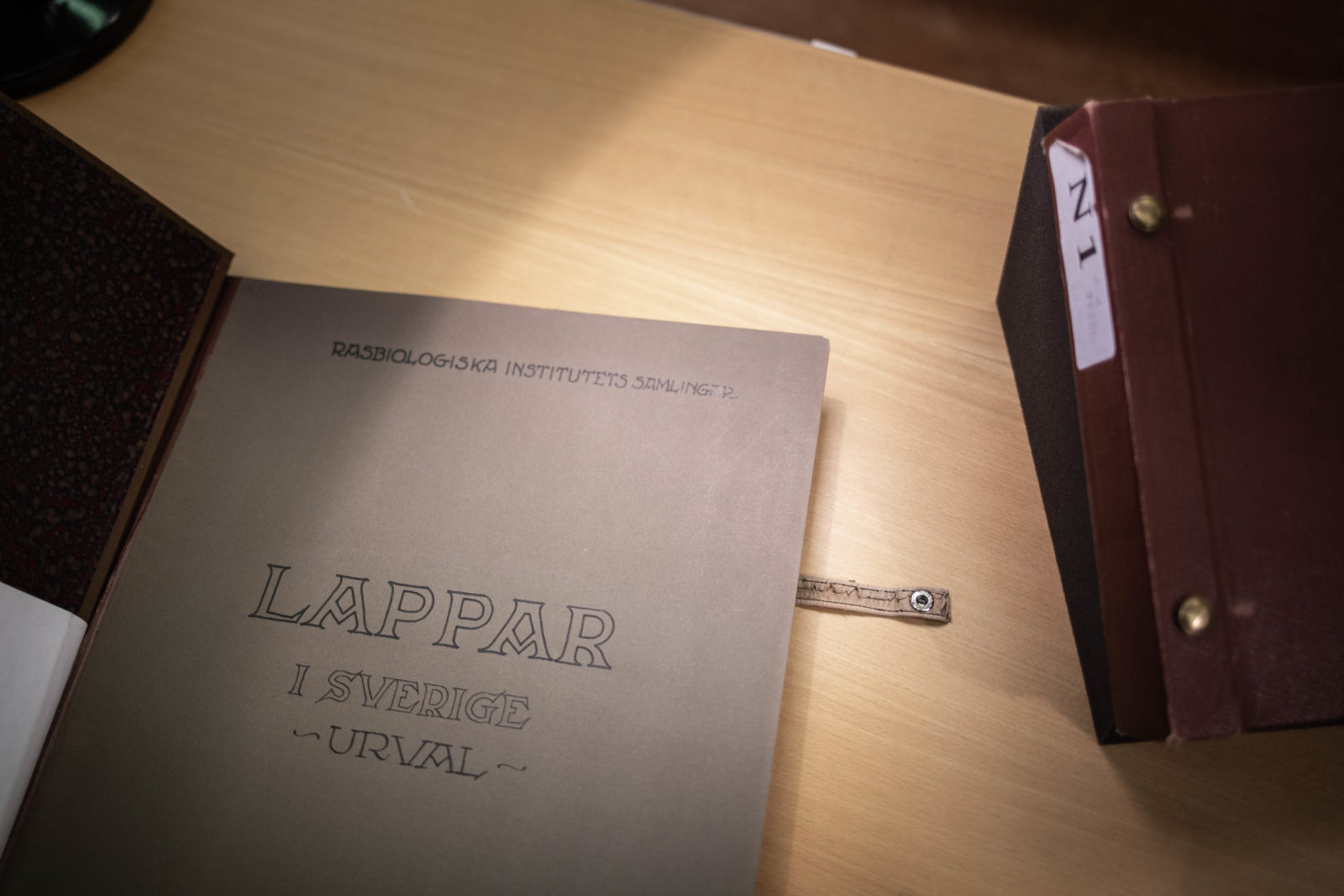
The archives of the Institute of Racial Biology in Uppsala, photographed on December 9, 2021, contain many photos of naked Sami – Photos Thomas Dévényi/Hans Lucas for Les Jours.
There is a thin line between exoticism and colonialism. It is that same curiosity that has led visiting researchers to take away many Saami objects. Like the sacred drums of the shamans of the past. Most were destroyed by the Swedish Church over the centuries, and today there are barely seventy remaining in museums and private collections. Only a handful are held by Saami institutions. In Sweden’s main Saami museum in Jokkmokk, four drums from the 17th and 18th centuries are on public display. “But they don’t belong to the museum,” says Tanja Sevä, an employee of the Saami Parliament. They belong to institutions in the south of the country, and are officially on loan. Even if this loan is for an indefinite period, “there is something strange about having to ‘borrow’ our heritage,” says the cultural department’s project manager. It is also strange to have to travel a thousand kilometres to admire the works of your ancestors in the capital. Today, the restitution of cultural objects is a real debate in the northern lands. “We probably won’t be able to repatriate all our heritage to Sápmi, and it may not even be desirable,” says Tanja Sevä, “but our people and our museums could at least have official ownership. Let us be the ones to lend our collections.”
It’s another, more sordid kind of looting that has preoccupied the Saami Parliament in recent years: the plunder of human bones, unearthed in northern cemeteries by researchers from all over the world. “Throughout the 19th and early 20th centuries, Swedish and foreign expeditions exhumed the bodies of our ancestors,” explains Rose-Marie Huuva. In the name of science, hundreds of skeletons were taken away, often with the collaboration of priests, for whom the eternal rest of the Sámi was of little importance.
For more than fifteen years, Rose-Marie Huuva has been campaigning for the stolen remains to be returned to the land from which they should never have been exhumed. This is a personal matter, because it was probably the skulls of her ancestors that were taken away by a scientific expedition in 1915 from the Ruonala cemetery in the far north of Swedish Sápmi. Tanja Sevä is in charge of this particularly difficult mission in the Saami Parliament. There are many obstacles and a lack of resources. The problem is knowing on which dusty shelves these stolen bones are stored.
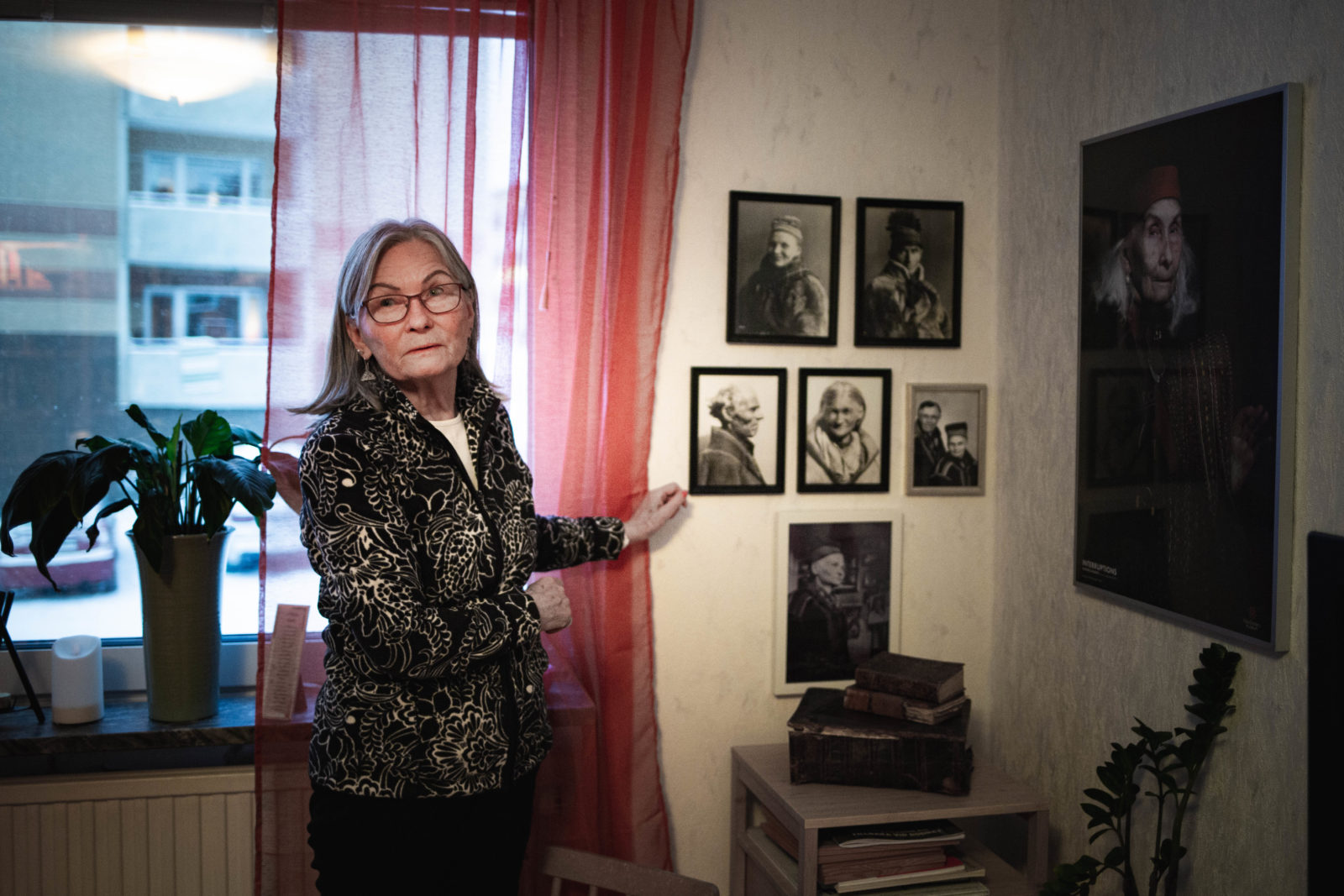
Carina Sarri shows photos of her ancestors, from the archives of the Institute of “Racial Biology”, which she hung at her home in Kiruna on November 25, 2021 – Photos Thomas Dévényi / Hans Lucas for Les Jours.
Although no one knows the exact quantity of remains that have been exhumed, it is estimated that at least one hundred – and certainly more – skulls and skeletons have been stolen from the cemeteries of Swedish Sápmi. The traces of these skulls and skeletons fade away with the miles and years. Where, for example, did the skulls stolen by “La Recherche” go? At the end of the 1830s, this French scientific expedition, led by naturalist Joseph-Paul Gaimard, stopped by a northern cemetery to exhume Sámi remains with the help of the priest Lars Levi Læstadius[8]. What happened to the “two bags full” of bones described in a letter from the priest, remains unknown.
In Paris, London and Berlin, probably dozens of bodies remain in archive boxes or private collections. From the 19th to the early 20th century, native skulls were prized objects that some collected and others traded like marbles. Tracing these human remains resembles a police investigation, and requires resources that Tanja Sevä simply does not have. “There are two of us in my department working on this issue, and it is not our only mission,” she sighs. So, for the time being, she is concentrating on the northern lands, which are more directly involved in the macabre trafficking of the past.
“We know that about one hundred bodies are in the archives of several museums in Sweden, Norway and Finland,” explains Tanja Sevä. For the former archaeologist, the work has also become personal. “I discovered last year that bodies exhumed in my home village, and therefore probably some of my ancestors, are now in Finland”. Across Sápmi, many families are also wondering about this, as there have been so many unauthorised exhumations. And in the northern regions, the subject has become a hot topic. “Today, Scandinavian museums know that this is bad for their image and are collaborating with us,” notes the project manager. The final irony is that the bones can only be returned to the ground with the express permission of the Swedish government, on the recommendation of the museum that “owns” them. From an administrative point of view, these skulls and skeletons have become “museum objects”, says Sevä, “objects” that the Sámi people “destroy” by burying them in their ancestral land. Moreover, these restitutions come at a cost. “And it is not the responsibility of our people to pay for it,” says Sevä, who hopes to obtain state funding.
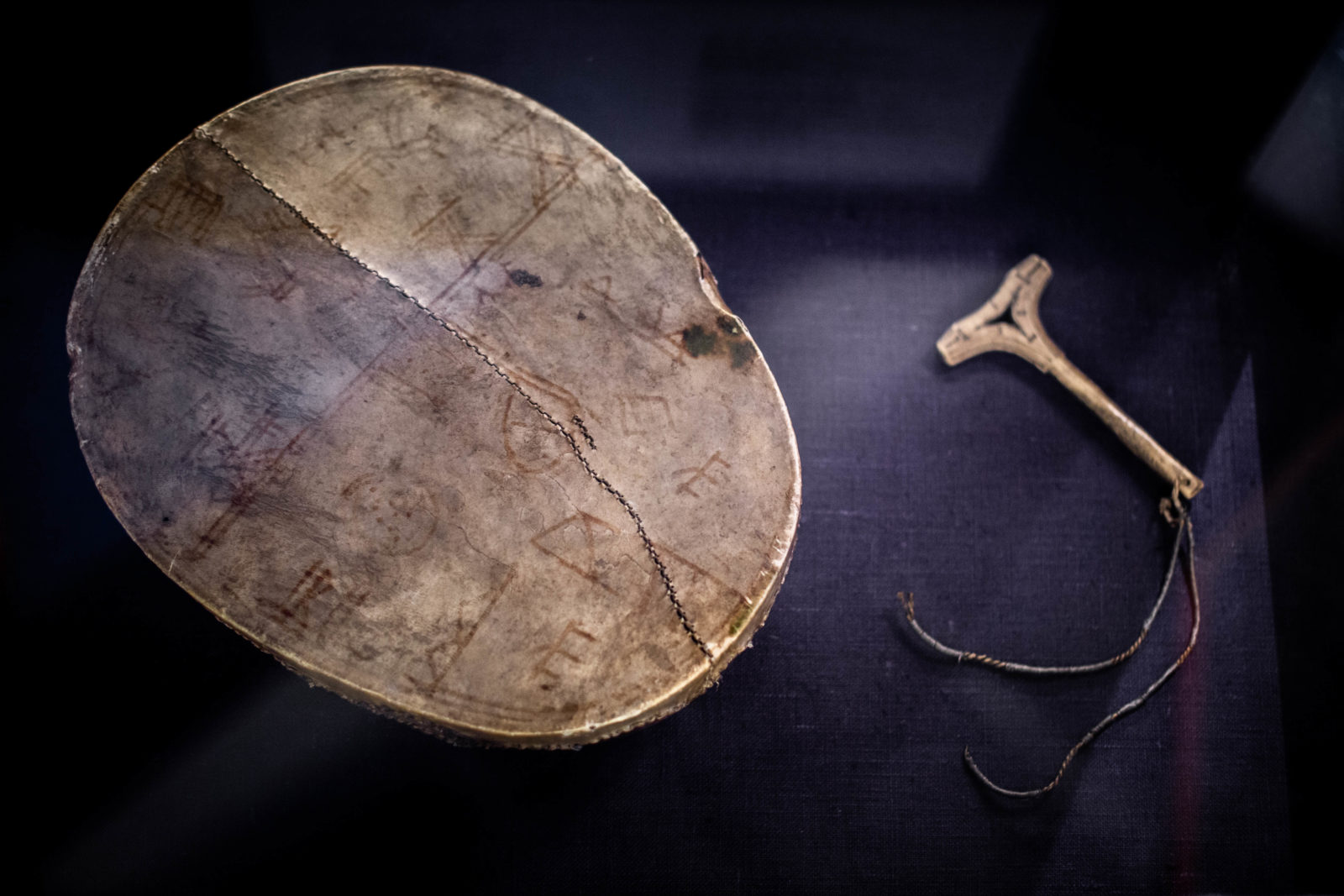
A sacred drum at the Sami museum in Jokkmokk, December 4, 2021 – Photos Thomas Dévényi/Hans Lucas for Les Jours.
In recent years, only five restitutions have occurred in Swedish Sápmi. The largest was organised in 2019, in Lycksele. “Thirty skulls and four skeletons were exhumed during an archaeological excavation in the 1950s, before the installation of a hydroelectric power station,” explains Mikael Jakobsson, leader of the local Sámi community. Five of the skulls and all four skeletons were never returned. They disappeared. The remaining twenty-five skulls were returned to the earth in a large ceremony in August 2019. Rose-Marie Huuva carried one of the coffins. “It was moving and important. What is buried in the earth should remain buried.”
Over the years of wrestling with the issue, the poet, who once wanted to be buried like her ancestors before her, has changed her mind. “Many of us Sámi now prefer cremation,” she says. “Is it the impact of history? I don’t know”. But as long as she is alive, this past will haunt her. Like this image, which she describes in a poem[9]:
“The headless skeletons
Of ancestors
Wait in their graves for
Resurrection.”
[1] Rose-Marie Huuva
Sámi artist
Rose-Marie Huuva is a renowned poet and visual artist from the Swedish Sámi community. She explores the different facets of Saami culture and exposes the darker side of Scandinavia’s colonial past. As a poet, she writes in Northern Saami and then translates into Swedish. “Keeping our language alive from generation to generation is a constant struggle,” she says. In the late 2000s, she convinced the Swedish Saami Parliament to make the restitution of remains stolen from Sámi cemeteries in the 19th and 20th centuries a priority. By dint of letters, petitions and public appeals, she got the attention of Stockholm and the museums of the South. For Huuva, this is personal. For it was probably the skulls of her ancestors that were taken by a scientific expedition in 1915 from the cemetery at Ruonala in the far north of Sweden’s Sápmi region. Long kept in the archives of the History Museum in the Swedish capital, the bones have been repatriated to Jokkmokk, where they are still waiting for the Swedish government to authorise their burial.
[2] Read Episode 4 of the serie « Samis pour la vie » : “In Sweden, is the Saami Parliament enough?”
[3] Racial theories and eugenics
Based on the theory that there are human races and a hierarchy between them, eugenics aims to select the genetic make-up of future generations by eliminating the transmission of any trait deemed a defect – a disability, a tendency towards alcoholism or any other social vice, or membership of an “inferior race”. In practice, these nauseating ideas led to various policies of forced sterilisation in Europe and in America, and to the “Final Solution” in Germany.
[4] Sápmi
Four states and three borders
From northern Norway to the Kola Peninsula in Russia, via the Swedish and Finnish Arctic territories, the Sámi territory has never been independent. The region is more commonly known as “Lapland”, derived from the name the Scandinavians gave to its majority population, the “Lapps”. They call themselves “Sámi”, and although their land has no borders of its own, many speak of “their country”, the Sápmi. Some 400,000 km² (160,000 of which are in Sweden) of forests, mountains and swamps where one encounters reindeer herds, lynx and solitary elks. In summer, swarms of mosquitoes hover over the tundra and the sun blazes all night, before the land freezes under ice and snow for more than a third of the year, and the northern lights illuminate the sky. The region’s mining, water, forestry and oil resources have contributed greatly to the economy of the Scandinavian nations and are now the keystone of their energy transition.
[5] Sámi/Saami/Sápmi [Sami/Sâme/Sapmi]
The term “Sámi”, which refers to these people in their languages, is translated abroad as “Sámi” [Sami] or “Saami” [Sâme], depending on the text. They refer to their ancestral territory, which stretches from Norway to the western peninsula of Russia, as Sápmi [Sapmi]. Here, we have chosen to use “Sámi” [Sami] to refer to people and “Saami” [Sâme] to refer to language, culture, institutions…
[6] Carina Sarri
Saami memory
A former teacher, Carina Sarri helped found Sweden’s first Saami nursery in Kiruna in 1983, and preserving the language has been her life’s work. “In the past, people in Sápmi spoke several languages,” she says. The region had a rich variety of cultures. But as Sweden’s assimilation policies continued, Saami languages were passed down less and less through families.
Now retired, Carina Sarri continues to participate in Saami language preservation programmes. And in her own way she preserves the memory of those who came before her. Her flat in Kiruna is like a small museum of intimate memories. It houses her family’s objects – the wooden cradle her grandfather made when she was born, designed to be carried on the back of a reindeer, her mother’s childhood doll, the only toy she ever owned – and portraits of her lineage.
[7] The Saami Parliament
Managing Sámi affairs
Founded in 1993 following the creation of similar bodies in Norway and Finland, Sweden’s Saami Parliament – Sametinget (in Swedish) or Sámediggi in Northern Sámi – is more of a government agency than a legislative body, despite its elected assembly.”Day-to-day, the Sámediggi deals with the management of Sámi affairs, from reindeer husbandry to cultural projects,” says its administrator, Fredrik Österling. But it has no power to legislate, only to be consulted by the Swedish government. The Saami Parliament has offices in four towns in Sápmi, about 60 employees and an annual budget – allocated by the Swedish government – of 66 million kronor (6 million euros) to manage various projects related to Saami culture. In addition, there is an extra allocation of 120 million kroner (11.2 million euros) just for managing the reindeer husbandry industry. Three to four times a year, its 31 members of parliament gather in plenary session in one of the main cities of the North. There are 10,000 registered voters.
[8] Læstadianism
A protestant religious movement founded by the priest Lars Levi Læstadius (1800-1861), of Sámi origin. Although it was a conservative Protestant movement, it spread widely among the Sámi population and was also inspired by the Sámi relationship with nature. The personality of its founder remains controversial, both for the extreme rigour of his doctrine and for the trafficking in Sámi skulls in which he is reported to have engaged.
[9] Poem
From the Saami poetry anthology “Viidát: divttat Sámis = Vidd: dikter från Sápmi” (Podium, Stockholm 2006), this poem was read by Rose-Marie Huuva at the Swedish Church’s official apology to the Sámi people for past abuses on 24 November 2021.
Translation by Ciaran Lawless / Voxeurop.






